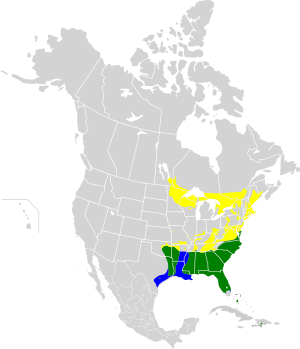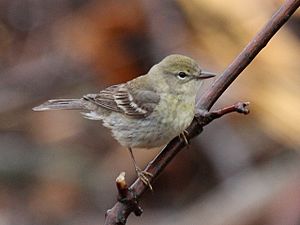Pine warbler facts for kids
Quick facts for kids Pine warbler |
|
|---|---|
 |
|
| Adult male | |
| Conservation status | |
| Scientific classification | |
| Genus: |
Setophaga
|
| Species: |
pinus
|
 |
|
| Range of S. pinus Breeding range Year-round range Wintering range | |
| Synonyms | |
|
|
The pine warbler (Setophaga pinus) is a small songbird found in North America. It's named for its love of pine trees, where it often lives and finds its food.
What Pine Warblers Look Like
These birds are quite small, usually about 5 to 5.75 inches (12.7 to 14.6 cm) long. They have white bellies and two white stripes on their wings, which look like little bars. Their legs are dark, and they have thin, pointed bills perfect for finding insects. You can often spot a yellowish line above their eyes.
Male pine warblers have olive-colored backs and bright yellow throats and chests. Females and younger birds are a bit duller, with olive-brown backs and paler throats and chests.
Their song is a pretty, musical trill. Their calls sound like slurred chips.
Where Pine Warblers Live
Pine warblers love to live in open pine forests in eastern North America. You can find them breeding in these areas.
Some pine warblers live in southern Florida all year round. Others migrate to warmer places for winter. They travel to northeastern Mexico and islands in the Caribbean.
How Pine Warblers Behave
Pine warblers are clever at finding food. They slowly search on tree trunks and branches. They even poke their bills into pine cones to find tasty insects. Sometimes, they also look for food on the ground.
Their main diet includes insects. They also eat seeds and berries, especially when insects are harder to find.
When it's time to build a home, pine warblers make deep, open cup-shaped nests. They usually place these nests near the end of a tree branch. As their name suggests, they prefer to nest in pine trees. A female pine warbler usually lays three to five white eggs, which often have blotches on them.
See also
 In Spanish: Reinita del pinar para niños
In Spanish: Reinita del pinar para niños



